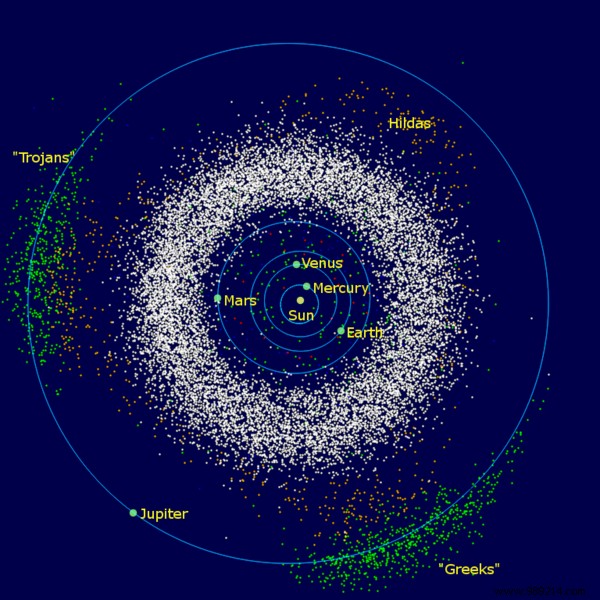NASA and its prime contractor Lockheed Martin are one step closer to launching their Lucy mission. The vessel has just completed the preliminary examination authorizing its expedition to the launch site, at Cape Canaveral (Florida). The objective of this mission will be to study several Trojan asteroids that evolve in the orbit of Jupiter.
Trojans are asteroids that share Jupiter's orbit around the Sun. They were amassed by the planet billions of years ago, trapped by its gravitational pull. These objects are divided into two subgroups:on the one hand the "Trojan camp", found on the Lagrange point L4 of Jupiter, and on the other hand the "Greek camp", found on the L5 point. The former are ahead of Jupiter (ahead on the line of orbit) and the latter are behind (behind Jupiter on the line of orbit).
Researchers believe that some of these could be primordial asteroids almost unchanged since the formation of the Solar System 4.6 billion years ago . To study them closely, the agency selected the Lucy mission in 2017 as part of its Discovery program.
Designed and built by Locked Martin in Colorado, Lucy will rely on three "derivative" instruments from previous missions.
Lucy's Long Range Reconnaissance Imager (LORRI) is a high resolution visible imager based on the LORRI instrument used by the New Horizons spacecraft. LORRI will provide highly detailed images of the surface of Trojan asteroids. Lucy's thermal emission spectrometer, based on the OTES (OSIRIS-REx Thermal Emission Spectrometer) used on the OSIRIS-REx mission, will be responsible for detecting the radiation emitted by asteroids. Finally, consisting of a visible multispectral imaging camera and an infrared spectrometer, the L’Ralph instrument is based on the Ralph instrument piloted on New Horizons. It will be used to measure silicates, ice and organic matter on the surface of Trojan asteroids.
Lucy will also wear a small plaque similar to the "Pioneer Plaque" attached to the Pioneer 10 and 11 spacecraft which has messages and diagrams engraved on it.
The mission passed its pre-shipment review in July 2021 and is being processed for delivery to Cape Canaveral in August. Once at the launch site, the spacecraft will undergo a final battery of tests before being placed in the payload fairing of its United Launch Alliance Atlas V 401 rocket. The launch is currently scheduled at the earliest for October 16 .

Once launched, Lucy will make two first gravitational flybys of Earth in 2022 and 2024 so as to be on the right trajectory. Before arriving in the Jupiter system, the probe will fly over the asteroid 52246 Donaldjohanson , found in the main asteroid belt between the orbits of Mars and Jupiter, on April 20, 2025. Lucy will use this object as a rehearsal for future flybys.
The probe will finally arrive at its first targets in 2027. It will then be in the L4 swarm which precedes Jupiter. Scheduled for August 12, 2027, the first flyby will take Lucy to the asteroid 3548 Eurybates (64 km in diameter). A little over a month later, the probe will focus on the asteroid 15094 Polymele (21 km in diameter), then on Leucus (34 km in diameter) seven months later, on April 18, 2028. The last asteroid of the L4 swarm visited by Lucy will be 21900 Orus (51 km in diameter) on November 11, 2028.
At this point, Lucy will leave Jupiter's L4 point and return to Earth to take advantage of new gravitational assistance in December 2030 . In this way, the probe will be able to move towards the point L5 of Jupiter (the swarm evolving behind Jupiter on the line of orbit). On site, normally in 2033, Lucy will examine a pair of binary asteroids (617 Patroclus and Menoetius) in a single flyby. The first is 113 km in diameter while the second is 104 km in diameter.
Once this is completed, the mission will end. From then on, the ship will become the only one in history to have visited eight different places in a single mission.